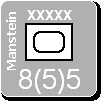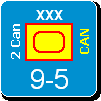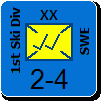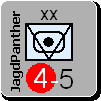Shannon V. OKeets
Posts: 22095
Joined: 5/19/2005
From: Honolulu, Hawaii
Status: offline

|
quote:
ORIGINAL: Froonp
The key reference to understand the below is :
************************************
2.4.1 When to check supply
You need to check the supply status of a unit before it moves, flies, sails or reorganises units.
You also need to check the supply status of land units immediately before you resolve an overrun (both sides), during combat declaration (attacking units) and at the moment of combat (both sides).
and
11.11.1 How to move land units
A unit must always end its move when it enters an enemy ZOC (exception: it can continue moving if it then overruns a land unit in the next hex ~ see 11.11.6). You can move a unit which starts its move in an enemy ZOC directly into another enemy ZOC (even a ZOC of the same unit).
************************************
quote:
ORIGINAL: Shannon V. OKeets
I am reading and commenting the Overrun code (from CWIF) and I have found a couple of things that do not look quite right. So let me see if I understand this correctly. I believe the following to be true:
Consider a stack of units (OS) capable of overrunning a weak defending infantry corps (W), and assume that all the numerous conditions for the overrun have been met. For clarity, by weak I mean that W is both disorganized and non-elite.
Case I - W is out of supply before OS moves.
OS starts in hex A, adjacent to W (in hex D) but can not overrun by moving directly from A to D because there is an intervening fort hexside. However, by moving laterally to hex B, OS can then overrun D because no fort hexside separates B and D.
I believe this move, from A to B to D is permitted because the exit from the enemy ZOC just entered (hex B) into hex D is an overrun.
If I understood correctly, B is also in W's ZoC.
I agree. OS can only move once they have entered W's ZoC, by overruning, what they do by entering D.
quote:
Case II - W is out of supply before OS moves.
Same as case I but there is a fort hexside between B and D also.
OS wants to, but is not permitted to, move from A to B to C (circling around hex D) to perform an overrun from C to D - the hexside from C to D does not contain a fort.
I believe the move, from B to c is not permitted because the exit from the enemy ZOC just entered (hex B) into hex C is not an overrun.
I agree.
After having entered B, OS can only continue moving by Overruning, which it does not by entering C.
quote:
Case III - W is in supply before OS moves, but only through the empty hex C.
Same as case I but there are no fort hexsides anywhere.
OS can not overrun W by moving from A to D, because D is still in supply and therefore at full strength. However, by moving to hex B, OS exerts a ZOC into hex C, thereby putting W out of supply and reducing its combat factors to 1. OS then overruns W by moving from B to D.quote:
I agree. The rules say that supply is checked before each move, before each combat and before each overrun. Note that OS must still be in supply in B too to do the overrun.
Case IV - W is out of supply before OS moves, but only because OS exerts a ZOC into hex E (directly opposite hex C). Hex E is controlled by W's major power.
Same as case I.
Now when OS moves to B (to get around the fort between A and D), W can trace supply through E, since OS not longer exerts a ZOC into that hex. Therefore OS can not overrun by moving A to B to D, because W is at full strength.quote:
Right, because the rules say that supply is checked before each move, before each combat and before each overrun. .
=====
The point of this exercise to make sure I understand perfectly when supply should be traced for deciding whether an overrun is permitted.
I think you have it.
Here is a diagram I made showing your 4 cases (I hope).

Yes. Thanks for the pictures. I really didn't have the time to create them.
========
I have one more detail that I want to confirm. When moving a stack of units for overrun, the cost for the stack to enter each hex is whatever the cost is for the unit that uses the most movement points. So, for simplicity's sake, if the stack does not start in an enemy ZOC can charges forward, seeking to overrun a unit, each hex it enters costs the number of movement points required to move the 'slowest' unit into the hex.
My concern is an armor unit, stacked with a leg infantry trying to move into a forest and then, later in the movement, overrun an enemy unit in a clear hex.
The leg infantry might have 4 movement points which is sufficient for it to move/overrun the enemy unit, since the forest hex only costs leg infantry 1 MP. The armor unit has 6 movement points, and though the move through the forest costs it 2 MP, it still can reach the enemy hex for the overrun.
However, since the two units must move as a stack in order to conduct the overrun, then entering the forest hex costs the leg infantry 2 MPs of its available 4 MPs, so it can not reach the enemy unit for the overrun. The same thing comes up when moving through mountains.
=========
I've another bone to pick about overruns.
The rules make a clear distinction between overrunning air & naval units, alone in a hex, versus when enemy land units are present. Now I have no problem with that, it is very clear cut.
But, supply units make me pause and wonder.
1 - Can a supply unit participate as an attacking unit in an overrun? It might be the only way it could get to the overrun hex (otherwise it would be violating the rules concerning entering and exiting enemy ZOCs. I am assuming yes.
2 - Does the presence of an enemy supply unit count as a land unit for the purposes of overrun? For instance, this might prevent an out of supply unit from overrunning a hex (because an enemy land unit - the supply unit- is present). The MWIF/CWIF code currently says says: yes, the presence of an enemy supply unit prevents movement into a hex (i.e., overrun) by an out-of-supply land unit, even though the odds would be X:0, or infinite.
_____________________________
Steve
Perfection is an elusive goal.
|
 Printable Version
Printable Version















 New Messages
New Messages No New Messages
No New Messages Hot Topic w/ New Messages
Hot Topic w/ New Messages Hot Topic w/o New Messages
Hot Topic w/o New Messages Locked w/ New Messages
Locked w/ New Messages Locked w/o New Messages
Locked w/o New Messages Post New Thread
Post New Thread